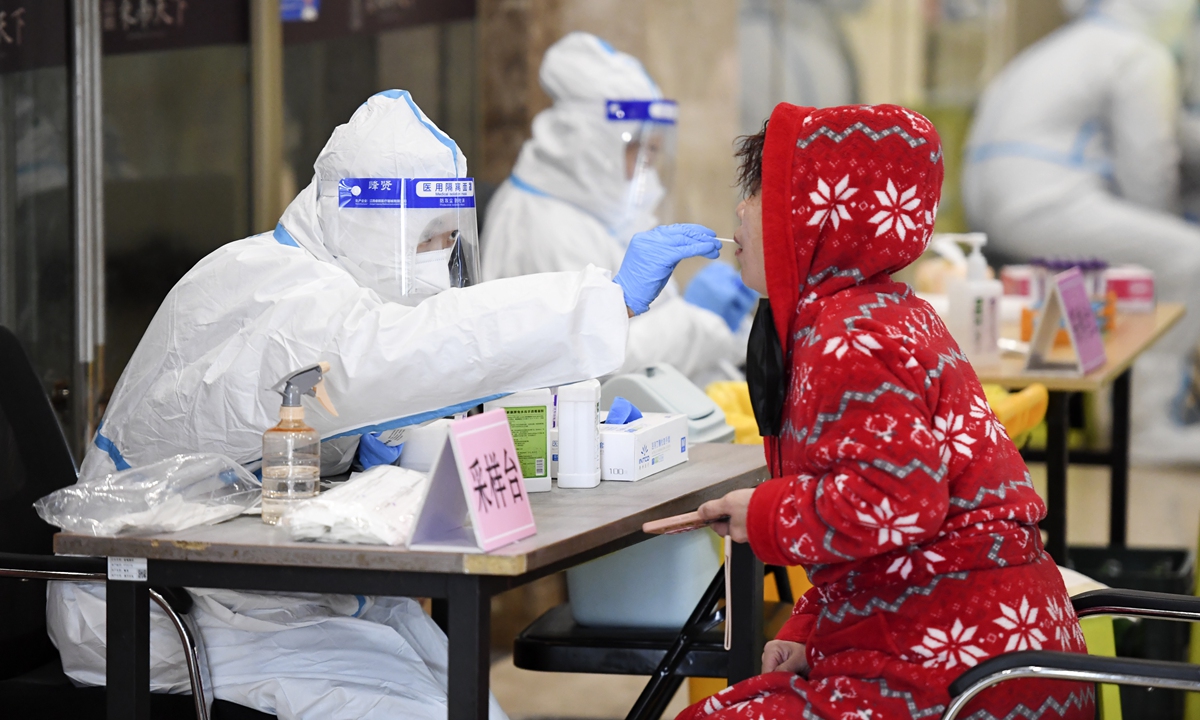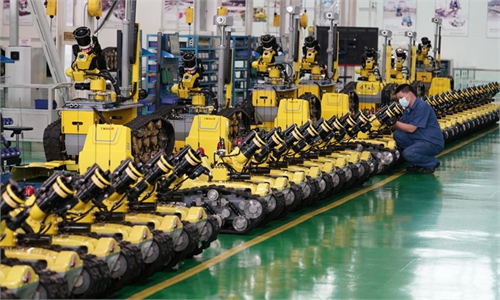Epidemic prevention and control has never been a single choice question: Global Times editorial

A resident takes the nuceic acid testing in Changchun, Northeast China's Jilin Province on March 13, 2022 as the city has started a new round of citywide testing. Photo: VCG
Recent days have witnessed a prominent increase in epidemic outbreaks across China and the number of infected people has grown rapidly. Since March, the number of locally infected COVID-19 cases has exceeded 500,000 with the epidemic emerging and rebounding in many places. At this critical juncture, it is more important for us to adhere to the general policy of "dynamic zero" and unswervingly ensure the safety of people's lives and health to the greatest extent possible.It should be noted that the essence of "dynamic zero" policy is high speed and accuracy. Past experience has proven that the "dynamic zero" strategy which aims to tamp down the outbreak once it's detected is effective and correct. Facing the Omicron variant which is featured by rapid spread, strong concealment, and a short incubation period, "fighting with speed" is still the key to prevention and control. Residents of Guangzhou have had the star removed from their health and travel code on April 22. It only took about two weeks from detecting the epidemic, taking decisive measures to eliminating it and resuming normal production and life. This is another successful practice of the dynamic zero policy that aims to achieve the greatest prevention and control effect at the smallest cost.
It should be also seen that China's epidemic prevention and control philosophy is "people first, life first." Preventing and controlling the epidemic is not antagonistic to having normal production and life as well as economic and social development. The two sides are complementary and in dialectical unity. The "dynamic zero" policy is meant to minimize the impact of the epidemic on economic and social development as well as its influence on people's production and life. In other words, taking a simplistic "one-size-fits-all" approach or increasing requirements during the implementation of the policy that ignores the reality is by no means the true "dynamic zero" policy.
The Omicron variant places higher requirements on the response of "early detection, early reporting, early quarantine and early treatment." It also tends to make some regions feel nervous, fearing that the area under their jurisdiction may be overwhelmed by an outbreak. But despite such attention and pressure, we cannot ignore the practical conditions and violate scientific rules. Some regions arbitrarily close off highways with the excuse of epidemic prevention and control, some impose "static management" even if no infections have been reported, and other places prohibit farmers from farming even if there is no COVID-19 outbreak locally. These practices are all twisting the dynamic zero-COVID policy. Attention has been paid to resolving those problems according to law. Meanwhile, we should also be vigilant to the tendency of seeking to avoid being punished by adopting radical control measures.
The key to epidemic prevention and control lies in adhering to being scientific. We cannot equate "dynamic zero-COVID" with zero infection, the measure of lockdowns and citywide nucleic acid testing. Or even think of citywide lockdown and nucleic acid testing whenever the "dynamic zero-COVID" policy is mentioned. In fact, the measures taken in such a strategy depend on which stage the COVID-19 epidemic is in when being detected. The measure of lockdown can be used only when the epidemic is already at a late stage, or it is detected at an early stage but not controlled in a timely and decisive manner, leading to greater community transmission. The scientific significance of the "dynamic zero-COVID" policy lies in effective identification and management of the source of infection, effectively cutting off the possible transmission chains, and not letting the epidemic cause continuous community transmission and large-scale resurgence of COVID-19 cases.
The most important aspect of COVID-19 epidemic prevention and control is coordination. From the very beginning of epidemic prevention and control, the central government has clearly put forward that we should be coordinated in the promotion of epidemic prevention and control as well as in national economic and social development. This means we should take all aspects into consideration, solve all the difficulties we are facing and "play the piano with 10 fingers." Prevention and control of the epidemic is a systemic project that needs to consider three points simultaneously: Control the epidemic, protect people's normal life, and ensure the necessary operation of the economy and society. All three are indispensable.
Epidemic prevention and control measures should be strict, but policies to safeguard people's livelihood should be warm. The warmer they are, the more powerful the execution of the epidemic prevention and control measures will be. In this sense, the prevention and control of the COVID-19 epidemic is not only a vital test of our governance system and the government's ability to govern, but also a direct test of Chinese officials' working ability and attitude toward work.
The practice of combating the COVID-19 epidemic in China has fully proved that the "dynamic zero-COVID" policy is in line with the situation of our country and science. It is proven to be effective and feasible, and is the best practice of the principle of prioritizing people and lives. Facing new challenges and tests, we should resolutely resist the lulling of our will to fight the epidemic, the weariness of combating COVID-19, trusting to luck, and relaxing our efforts. We should also firmly oppose formalism and bureaucracy. In doing so, we will be able to continue to consolidate the hard-won results of epidemic prevention and control, and strive to win the dual victory of successful epidemic prevention and control and great economic and social development.



